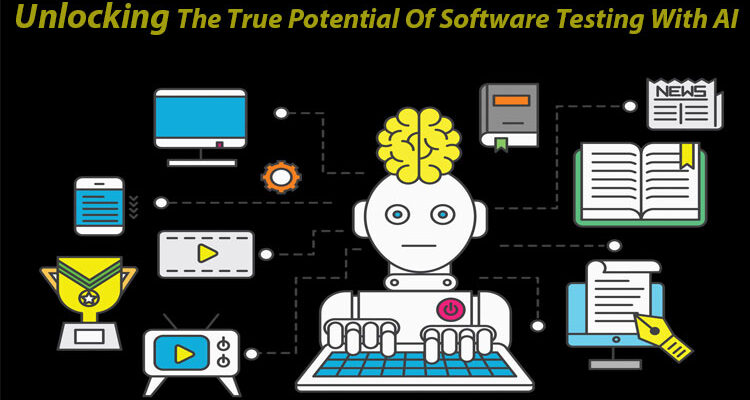Software Testing With AI – An Introduction
With technological advancements and a boom in the IT business sector, the software development life cycle has become more complex. With the lightspeed timelines of new product launches, there is hardly any time or space for manual software testing. The testing process now needs to be smarter, faster, and efficient enough to eradicate the errors of human testing.
For the same reason, software development organizations are increasingly relying on AI and ML to accelerate their operations. Artificial Intelligence and Machine Learning development services can bring great relief to software companies and their developers when it comes to testing.
The critical advantage Artificial Intelligence can provide is reducing the involvement of developers during the testing stage, primarily when their talent could be utilized elsewhere. This blog focuses on the true potential of software development that Artificial Intelligence development services can uncover.
The Benefits Of Implementing AI In Testing
The contribution of Artificial Intelligence in the software development sector is still at the inception stage, with a vast untapped reservoir of possibilities. Artificial Intelligence and Machine Learning technology is not brand new anymore but has massive scope for revolutionizing software development. Listed below are the key benefits a software development organization can reap by leveraging the power of Artificial Intelligence development services for testing.
- Fast-tracked Testing: Manual testing is time-consuming and makes a dent in the budget by wasting talented resources. Changes in a code require new tests, and regression testing loops can exhaust your quality assurance professionals. With AI, you will be able to automate test processes, facilitating accurate and ongoing testing faster than manual testing. Unlike in controlled application testing, utilizing test automation employs the results of thousands of virtual users. The AI tools also accurately detect how many tests the changed code requires to undergo instead of running all of them.
- Improved Accuracy In Identifying Defects: Since the test data grows, it is expected to find an increasing number of bugs too. While using traditional testing techniques, bugs can go unnoticed for extended periods, quickly becoming problematic. AI can detect and analyze such defects within seconds. You can rely on AI to automate bug detection and auto-correct codes, while bug tracing is allotted to the quality assurance teams to take forward. AI captures fingerprints of failures on the debugging logs to identify duplicate defects effectively.
- Automatic Script Execution: AI automates the test scripts using an algorithm while also sorting through log files. This gives test cases better stability when the locators are switched. AI can also give test scripts self-learning properties by learning the page-load behaviour to receive mock responses from the server.
- Adaptive Learning: Artificial Intelligence bots evolve with every change in the code to adapt to new application properties. When a code change is detected, the AI determines if these are new functionalities that need to be integrated. AI algorithms are constantly evolving with every update, thereby improving the quality of products.
- Write Automatic Tests by Spidering: AI is known to be able to conduct multiple tests simultaneously. With the help of Machine Learning, an AI tool can automatically write tests by spidering, a feature that can “crawl” through the software to gather data. This data helps to train the ML model about the software. Once the ML model understands the application, it compares results with expected patterns and raises flags in case of a deviation. By analyzing test coverage, AI can detect risk-prone segments with lower coverage.
Ways to Implement Artificial Intelligence in Software Testing
With properties like reasoning and problem-solving, Artificial Intelligence can be relied upon to promote greater levels of automation, reduce redundant and mundane tasks that waste time and capital during the developmental and testing processes. Here are ways that you can actively implement AI in software testing.
- API Testing: Application Programming Interface (API) test generation and the UI are complementary elements. AI examines the patterns and relationships in API calls made while exercising the User Interface. Using this assessment, it can develop a series of API calls and parameters that require testing. By understanding the user experience, AI can generate sophisticated patterns and inputs to testing an API. These tests will cover a lot more edge cases to enhance the quality of APIs.
- Continuous Testing: Continuous testing with the help of AI will help you spot the most negligible altered controls better than human eyes. Risk-based automation enables you to decide the tests required to be run on critical features in a limited time frame to get the best coverage. Continuous testing to identify irregularities becomes simpler with the help of AI and data analysis to create crucial new tests as the code expands. The QA test conductors can manually update such test cases to find the controls and detect the relationship between defects and components better than on manual testing.
- UI Testing: AI can be used to conduct visual testing of the contents of a web page’s user interface. They can be challenging to automate because judging the layout requires human analysis. Machine Learning visualization tools can help detect differences in images more accurately than humans. AI conducts tests to eliminate the manual input in processes like updating the Document Object Model (DOM), framework building, and risk profiling.
- Generating Unit Tests: Developers can spend less time maintaining tests by using AI to generate unit tests. AI can assist in the static analysis of an application to determine the segments of the code neglected by unit tests. Your AI tool can take this data and create unit tests and give input regarding codes not covered. It’s simpler to make unit tests with the tool because there is no setup or interaction required with additional components. The AI can update itself and maintain the code every time it changes.
- Creating More Reliable Automated Tests: How often have your tests failed because developers made changes to the application? AI tools can utilize machine learning technology to adjust to changes such as renaming a field ID automatically, making tests reliable and easy to maintain.
Conclusion:
While the future of Artificial Intelligence in the software development business looks bright, this journey is all about exploring endless possibilities. Machine Learning and Artificial Intelligence are technologies that have a huge reservoir of untapped potential that is yet to be discovered.
Understanding the areas, they can be implemented in software or custom mobile application development, which gives rise to a whole new generation of tech. The prospects of this coalition look very promising, but we have barely scratched the surface!




